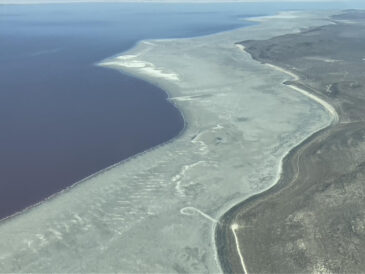Farmers want to help the Great Salt Lake, but feel like ‘scapegoats’ for a more complex problem
In search of solutions, USU researchers highlight insights from farmers, who use most of the water that would otherwise flow to the Great Salt Lake. Farmers argue they share the same existential threat as the lake: ‘unrestrained growth’

Courtesy Bryn Watkins
The shore of Great Salt Lake, left, is pictured alongside its historic shoreline, right. The Spiral Jetty lies between them on the dry and dusty lakebed.As the search for solutions to the shrinking Great Salt Lake continues, researchers at Utah State University opened up conversations with the biggest water users in the state: farmers.
Among the findings resulting from those interviews is that farmers in the Great Salt Lake Basin feel they are “scapegoats” and “unfairly blamed” for the complex problem. They say amid debate around the lake, critics often don’t recognize that as the lake has declined, so has agricultural water use. And farmers argue that they have something in common with the Great Salt Lake — that their existence is threatened by the same thing: “unrestrained growth.”
That’s according to a new report published this week on USU’s Community and Natural Resources Institute’s website, authored by Bryn Watkins and Stacia Ryder. Watkins recently earned her master of science degree from the Department of Environment and Society at Utah State University, and Stacia Ryder is an assistant professor in the School of Social Sciences Department at Utah State University.
Agricultural water use accounts for 67% of water withdrawals that would otherwise go to the Great Salt Lake, according to the report. The shrinking lake poses a grave threat to the state in many ways, including its economy and the health of Utahns, so policymakers and researchers continue to search for ways to keep the lake healthy long into the future.
“However, many solutions that have been proposed and pursued have lacked in depth input from those within the agricultural industry,” Watkins and Ryder wrote.
So, last spring, Watkins conducted “15 semi-structured interviews among commodity farmers in the Great Salt Lake Basin about their experiences at the crux of these problems.”
Watkins told Utah News Dispatch on Wednesday that those interviews included about 20 farmers in the area with diversified farms. They all grew alfalfa or other types of hay or crops. She said they also included cattle ranchers and ranchers with other types of livestock.
All of them, Watkins said, expressed a deep sense of concern and care for the land they manage and the role they play in the food supply chain.
“That’s their purpose. They want to feed their community, and they feel very responsible for it,” she said, adding that the farmers are “very seldom making a buck” and are often “barely solvent.”
Some of their stories, she said, were “heartbreaking.”
“They are experiencing the loss of their heritage as development encroaches on ag land,” Watkins said. “And they’re also worried about the health of their soil and water.”
But as the debate over the Great Salt Lake rages on, Watkins said farmers feel like “everybody’s pointing their fingers” at them and they’re being “alienated by the rhetoric,” even though they want to be part of the solution.
“When we pit agriculture against the lake, then we miss the fact that they’re both under the thumb of this bigger problem, which I think is growth in Utah,” Watkins said. “Unregulated growth.”
What farmers told researchers
While farmers “certainly feel these connections to the land and water, they believe that when it comes to conversations about the drying lake, they tend to be viewed as the sole destroyers,” according to the report.
“Further, they see themselves as being used as scapegoats who are disproportionately expected to change their water consumption patterns in order to save the Great Salt Lake,” the report said. “Yet, they all note an important but often overlooked fact: as the lake has declined, agricultural water use has declined too.”
One farmer was quoted in the report saying: “Everybody gets mad that the farmers use all the water. Tell me what, there’s one thing changed in 100 years since Bear Lake and this water system got put in 120 years ago. One thing has changed. Farming’s not getting bigger. Why do we have a water problem now?”
Farmers, Watkins and Ryder wrote, say they and the Great Salt Lake “actually suffer from the same threat: unrestrained growth that puts both the lake and their own livelihood at risk.”
“So, while willing to participate in water conservation efforts like irrigation optimization programs, farmers are wary to cede resources to urban institutions they don’t trust and by whom they don’t feel respected or understood,” the report said.
It’s not just climate change that’s threatening the Great Salt Lake, Watkins and Ryder wrote. Utah’s rapid population growth has also been contributing to its struggles, the report says, noting “a changing climate paired with human overconsumption has contributed to the drying of the Great Salt Lake.”
“Rising temperatures will lead to greater evapotranspiration and decreasing headwater streamflow and groundwater storage, resulting in increasing dryness in the Great Salt Lake Basin regardless of human water consumption,” the report says. “This in turn threatens the ecosystems, economies, and cultures of the Great Salt Lake Basin, accelerating the local impacts of climate change.”
Looking ahead, Utah is on track to continue to grow, with a population that’s projected to at least double or maybe even triple over the next 40 years. Demand for housing is also projected to continue to rise, with the state estimated to need to build 27,900 homes per year for the next 20 years to keep pace with demand.
“This creates a complicated issue where in order to address the drying of the Great Salt Lake, regional population growth must actually be coupled with reduced water consumption,” the report says.
Solutions?
Ryder said that to farmers, the Great Salt Lake “is one piece of the conservation puzzle. … They see the issue from a more holistic perspective when it comes to the environment and ecosystem.”
“In discussing the issue, they advocate for a broader, more farming-friendly perspective to address drought,” the report says. “This includes considering how potential solutions for increasing water to the Great Salt Lake might lead to other environmental issues.”
For example, while discussing the potential of “water-intensive agricultural fields to be converted to solar farms,” the report said, “one interviewee noted that this could lead to other localized issues: ‘You gotta keep the weeds down and if you don’t, you either gonna have a weed explosion or a dust problem. You’re moving one dust problem from another.'”
Watkins said one of the report’s biggest takeaways was that growth development pressures also need to be factored into the debate.
“I don’t think it’s a matter of saying, ‘stop building,'” she said. “I think it’s just about building smart. I would like to see Utah grow up rather than out. It would be great to see more vertical housing, high density, small footprint, in places that we already live.”
She added that farmers feel “really on the back foot” when it comes to development pressures, and at the same time they’re also facing criticism from Great Salt Lake advocates who are “begging them to use less.”
“We do need to use less — and also it would help somewhat if farmers were insulated from that encroaching development,” Watkins said. “If there were limits to zoning, if there were regulations on how many large plot homes (are allowed) to every small, high-density home, if that ratio were maybe skewed toward high density, vertical housing instead of these larger homes that take up a lot of lawn and a lot of space and gobble farmland.”
Should alfalfa be grown in Utah?
Ryder acknowledged that some argue alfalfa shouldn’t be grown in Utah’s desert climate in the first place.
“We know alfalfa is not native to this area,” she said. “Should it have been started as a crop in a dry climate? It’s a good question.”
But she also pointed out when people debate the Great Salt Lake, some people say “we shouldn’t even be living here to begin with … it’s a desert.”
But Ryder said both of those arguments don’t acknowledge the reality of the present. “The reality is we’re living here, we’re developing alfalfa here,” she said. “How do we address these problems while also recognizing that these things are embedded in life as a Utahn?”
Watkins said there’s a slew of reasons why alfalfa does make sense as a crop in Utah and the West, including that it’s a great “nitrogen fixer” and helps reduce soil erosion. While alfalfa does use more water than many other crops, it can also have “greater water use efficiency,” according to the USU Extension, when comparing its harvestable biomass to other crops.
Alfalfa is also a major part of the West’s agriculture. Each year, it’s grown on about 6.8 million acres in 11 western states, including Utah.
“Nationally alfalfa is the third most important economic crop and its production in the West alone was worth 8.5 billion dollars in 2018,” according to USU Extension’s website. “It is also a major feed source that supports milk production (13.7 billion dollars in 2018) and the several other livestock industries in the West.”
Watkins said the debate makes her think about cream cheese.
“Here’s the reality. I think that we forget, sometimes, when we’re talking about alfalfa, that we are talking about our food,” she said. “I don’t know that people always connect when they see a flood-irrigated alfalfa parcel … I don’t think they see that and understand the supply chain that leads to the cream cheese in their fridge. But that is true.”
She pointed to Schreiber Foods in Logan, a major cheese and yogurt distributor that “makes most of the cream cheese in the U.S.”
“We all have to acknowledge that the benefits of our food system do come to us, even as we’re all collectively suffering some consequences as well,” Watkins said. “We’re all in this together. So I think we have to have a lot of deep respect for the heritage that we as Utahns have with agriculture, including alfalfa farming.”
Watkins said when it comes to the Great Salt Lake, saying “alfalfa farmers have to go” is “really unproductive rhetoric.”
“We don’t have to silver bullet it and say that they’re the problem and once they get out of here, then we’ll be OK,” she said. “Our food system depends on them. We depend on them. We’re part of the community together, so I think everybody has to pitch in, and they’ll pitch in too. But they can’t be the whole problem.”
Utah News Dispatch is part of States Newsroom, the nation’s largest state-focused nonprofit news organization.



